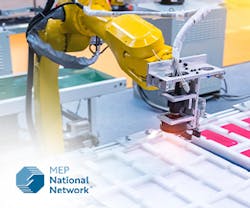The days are long gone from when manufacturers could add more staff to solve their operational issues. In fact, as the realities of long-term shifts in the workforce have set it, manufacturers increasingly cite automation as a solution to their struggles to find workers. It’s no longer about labor costs; it’s about finding ways to get work done.
The benefits of automating elements in your manufacturing operation extend beyond higher efficiency and improvements in quality. The ability to redeploy employees to perform more value-added tasks has become a primary motivator for many manufacturers to pursue automation.
Selecting the right automation for your shop involves many variables. You can make the initiative less daunting and achieve long-term positive results if you consider the following:
- Assessment and readiness: You benefit most from automating an efficient operation. This is the time to remove inefficiencies from your workflow.
- Impact vs. timeline and costs: Look beyond the labor cost savings and include the costs of equipment and your projected payback period.
- Quick wins before bigger projects: Change is hard, so start with something you can build upon.
Conduct an Assessment: Automation has its Roots in Lean Manufacturing
Automation itself is based on Lean manufacturing principles – identifying value and creating a repeatable, efficient process. Your automation assessment begins with a look at your entire operation, often referred to as value stream mapping (VSM). You are documenting all of the steps in the manufacturing process, including volumes of materials, staffing variables, and the timeline of steps in the process. Done properly, VSM removes waste from a manufacturing process and makes it as lean and efficient as possible.
- Your readiness for automation and what you should address first
- Possible areas to address in your facility layout to eliminate/reduce wasted motion
- The greatest cause of downtime
An assessment also helps you visualize opportunities and a possible future state. If you can automate inspections, you may be able to take on additional work that one of your customers has asked you to do. There also may be an “opportunity cost” from a direction you choose. If you do not reduce wasted movement in your facility, any additional output or growth will create backlogs that may jeopardize your delivery times.
Impact Begins with Low-Hanging Fruit
Another consideration for choosing the right automation solution is addressing processes with low complexity. Low-hanging fruit initiatives can be used for introducing the organization to automation, serving as a learning opportunity before taking on more complex and impactful processes. This is one reason why adding a cobot (collaborative robot) to work side-by-side as a human assistant is an increasingly popular first step. Cobots are easy to program and can be used for tasks that would typically require a person to stand for long periods at a machine or work station.
Potential areas to address as an introduction to automation include:
- Low-value "D" tasks
- Dull
- Dirty
- Difficult
- Dangerous
- Line operations
- Machine tending
- Pick and place
- Palletizing
Automation can be a win-win from an efficiency/workforce perspective, as well as providing staff members with higher job satisfaction and improving retention. Four possibilities for repurposing employees include:
- Autonomous vehicles and loaders: Repurpose someone who is moving materials from the warehouse to the shop floor
- Quality inspections: A robotics arm, with a camera to inspect parts, frees your employee to focus on more advanced tasks
- Machine monitoring: Make your data work for you, and repurpose someone from operating one machine to monitoring many machines at the same time
- Machine tending: a robotic arm, with the correct end-effector, can help to load and unload high volume/low mix parts in CNC machines, allowing for the operator to be used for more technical and hard-to-automate tasks
What Automation Option Will be Easier to Deploy
- Quick wins: These are similar to low-hanging fruit in that they are often less complex processes, but they have greater impact. A quick win gets the attention of skeptics and motivates early adopters. It also may allow you to repurpose an employee into higher value tasks. Don’t underestimate the potential boost in morale.
- Address highly visible areas: Everyone in the shop is aware of wasted movement, housekeeping issues, and the imbalance of operations that lead to a bottleneck. Successfully addressing long standing issues can also build momentum.
- Low or moderate disruption to existing processes: This could help you choose between similarly graded applications for impact as an initial jumping-off point. One option might involve a new material-handling system plus a robot arm, whereas a second option may be a machine tending system without the need for new conveyors or frequent material movement, which would be more disruptive to implement.
- Phased rollouts: This can be particularly helpful when a company is doing a large portion of the install and programming themselves. Trying to automate 100% of everything done in a work cell will almost certainly be more painful, and take longer, than a semi-automated first step with the goal of full automation, eventually.
What Pain Points in Your Operation Can You Address
It has not been easy for small- and medium-sized manufacturers to overcome hurdles in order to adopt more automation into their operations. Many shops have a high-mix, low volume of specialty work, which may mean significant programming time and the need to employ specialty skills. Capital costs can be high for automation equipment, and good system integrators can be expensive and hard to find. That means job shops and smaller manufacturers must have solutions that can do as much as possible for their investment.
However, there are automation solutions for simple but labor-intensive operations such as:
- Flexible feeders, which rely on vision, that can feed multiple sizes of parts
- Box erecting
Experts at Your Local MEP Center Can Help You with Automation
Experts at your local MEP Center can help you choose the right automation solution for your shop with an unbiased approach and access to specialty vendors. The Purdue MEP Center has partnered with two other MEP Centers – IMEC and CIRAS – to provide a free webinar, seminar, and workshop series to educate manufacturers about the benefits of automation.
About the authors
Robert Goosen, Associate Director – Engineering and Technology Services
Craig Zehrung, Senior Manager – Technical Assistance Program
Kyle Squillace, Technology Acceleration Specialist
Purdue MEP, a part of the MEP National Network™, provides high-value solutions for manufacturers in Indiana by identifying areas for improvement, helping to streamline processes, and increasing competitiveness. Purdue MEP serves hundreds of companies annually by implementing continuous improvement principles in the areas of productivity, growth, and technology.



